Connecting the Dots
It was a trip to the famous Bandel Church on a chilling winter day some years back. Located around 60 KM away from Kolkata, the capital of West Bengal. The Bandel Church is a “Must Visit” for every Bengalis in December – January season. Be it for a picnic (nowadays it has been stopped to save the heritage) or for a day’s out, Bandel is solely famous for this oldest Christian Church in West Bengal, although it houses the famous Imambara and other worthy places to visit.
You might wonder, it is a series of writing related to Temples (and especially the lesser-known temples of India), then how a church is poking its nose! Well, there is a link (Not Missing anyway). People who are fond of architecture will surely visit a nearby temple named Hangseswari Temple in Bandel (Will write on this later, not now). With a deity named Devi Hangseswari (a form of Maa Kali in Hindu Mythology), this temple is a popular one over the years. While moving around the spacious area of the temple and to have a sneak into the ruined “Rajbari”, suddenly one Temple caught the attraction. This is the same “Aath Chala” style of the temple that is been adopted in Bishnupur with the famous Terracotta inscriptions (Read Bishnupur Diary for all such Temple and its History as well as Architecture). Curiosity dragged me and found it is a “Bishnu” temple.
The Blackstone deity of “Vasudev” has been replaced by a stone structure of God. Vasudev or Krishna is worshipped here and it has a long history way back to 1679 as mentioned therein. ASI is maintaining the property and after restoration work, it resembles the earlier look. Terracotta style design in the wall depicting stories of Ramayana, Mahabharata & Lord Krishna. Even Rabindranath Tagore sent a young promising artist (later became famous) Nandalal Bose to draw the pictures and he did for one month passionately. It is not known who constructed this Vasudeb Temple but there are high chances of any of the Raja Rameswar Ray or his descendent Raja Nrishingha Ray or anyone related to them. Rameswar Ray was instrumental in building a fort in that area by cleaning the bamboo trees and the locality was named Banshberia (In Bengali, Bamboo is called Bansh). It’s a different story that you can read in the Hangeseswari Temple article. So, possibility of building this temple by Rameswar Ray is very high.
After several years, when I visited the famous “Ananta Vasudeva Temple” at Bhubaneswar, the dots became connected. Bengal met Odisha and here starts the inside journey to one of the oldest temples in the entire state.

Temple History
Talking about that time when Bengal was ruled by Muslims led by Giyasuddin, the successor of Bakhtiyar Khilji who was linked to Qutub Uddin Aibak. After Bengal, Giyasuddin tried to capture both Assam (then Kamrup) and Orissa (then Kalinga). It was the heroics of Orissa King Anangabhima III (Founder of Cuttack & Barabati Fort as well as developer of Chateswar Temple & Jagannath Temple at Jajpur) who with the help of his Commander Vishnu overruled Muslim invasion in the state. After demise, his son Narasingha Deva I (Who worked on Konark Sun Temple, Kapilash & Simachalam Temple) carried the legacy and it is his sister Chandrika who was instrumental in building the Ananta Vasudeva Temple at Bhubaneswar.
Chandrika was a pure follower of lord Vishnu and had expertise in music and dance. With permission from her elder brother and then King, Narasingha Deva I, Chandrika erected this temple. And to make a mark of her father’s heroics in fighting with other neighboring rulers, she arranged the Inscription on the wall of Ananta Vasudeva Temple that is still clear to be read by any enthusiast. Let’s look at the inscription:
“Yadvamse-Vaijayanti-Patamiva-Subhato-Anangabhimah Pravavah
-Pradhvastaratiraja Vraja -Yuvati-Yanodgita Gambhirasarah
Asidasivisire-Radhikataratarasta Drugarvorugarobah-Svante
Svantapasarpata Yavamapi Yavanam Sangare Sanjahara”
Of course, it has a meaning and it says, “In Chodaganga Deva’s lineage was like a flag the heroic Anangabhima, whose profound strength was celebrated by the damsels of a multitude of hostile kings destroyed by his power, and who was exceedingly proud of his swift horses, the speed of which surpassed that of snakes’ foes Garuda. He made an end of the war by defeating the Yavanas with impetuosity after entering into their territory beyond the frontier.”
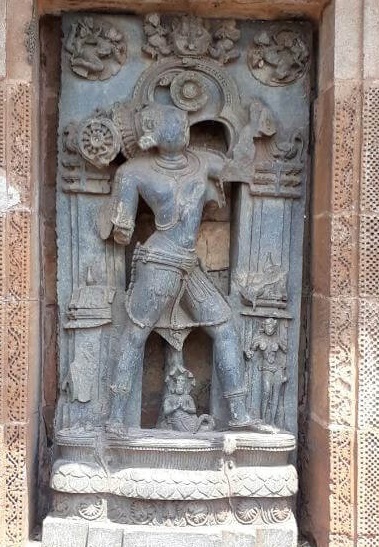
That was Chandrika of the Chodaganga dynasty (known as Eastern Ganga Dynasty also). Some people say, the idol of Vishnu was worshipped earlier before the construction of the temple – but yet to receive any proof of that. But, when Maratha rule was there in Orissa in the 17th Century, they renovated the temple to keep its originality.
About the Temple
Ananta Vasudeva Temple is a typical Hindu temple dedicated to Lord Krishna who is worshipped here in the form of Vishnu. Situated in the Old Town on the banks of the famous Bindusagar Lake, this temple is the only Vishnu Temple available now in Bhubaneswar.

From the Sandstone slab recovered from the temple site along with the above picture which is now in British Museum, there are inscriptions in seventeen lines mentioning the foundation year as 1278 AD. Let’s read what the inscription states:
“was built in 1278 AD by Chandrika, daughter of Anangabhima III, during the reign of her nephew Bhanudeva I (AD 1264-1279) for Ananta and Vasudeva”. It further states:
The inscription starts with an invocation to Shiva. Choda-Ganga is said to be the sole emperor of the earth and his dominion extended from the Godavari till the Ganges. In his lineage was born Ananka-Bhima (Ananga-Bhima III) who had defeated the Yavanas. His daughter was Chandrika (given name Chandra Devi) who got married to Paramardin, from Haihaya lineage. Paramardin is told to be deceased in a battle fighting for Vira-Narasimha-deva. Then came the description of the province of Utkala, the holy place Ekamra and Bindu-Saras (Bindusarovar) within it. It is told that in Ekamra dwelt the Lord of the Mountain’s daughter, known as Krittivasa. In Saka 1200 (1278 CE), during the reign of king Bhanu, son of Narasingadeva, Chandrika constructed the temple for Hari at the banks of Bindu-Saras. She enshrined Baladeva, Krishna, and Subhadra inside the temple. The inscription is composed by Umapati.
Sandstone Inscriptions

This 46”x20” sandstone was excavated by Field Collector Major General Charles Stuart of East India Company along with 3 others like Bhatta Bhavadeva, Megheswar, and Brahmeswar who are at the Asiatic Society of Bengal, Kolkata. Stuart was a collector of Indian sculptures (Mainly Eastern India – Bengal, Orissa & Bihar) and was in India till death in 1828. Known as “Hindoo Stuart” for his affection towards Indian history. In fact, Stuart opened a gallery at his Calcutta residence (Wood Street) for public viewing. After his death, the collections were auctioned in London and mostly are now kept in the British Museum, London. “Hindoo Stuart” was buried at South Park Street Cemetery, Kolkata.
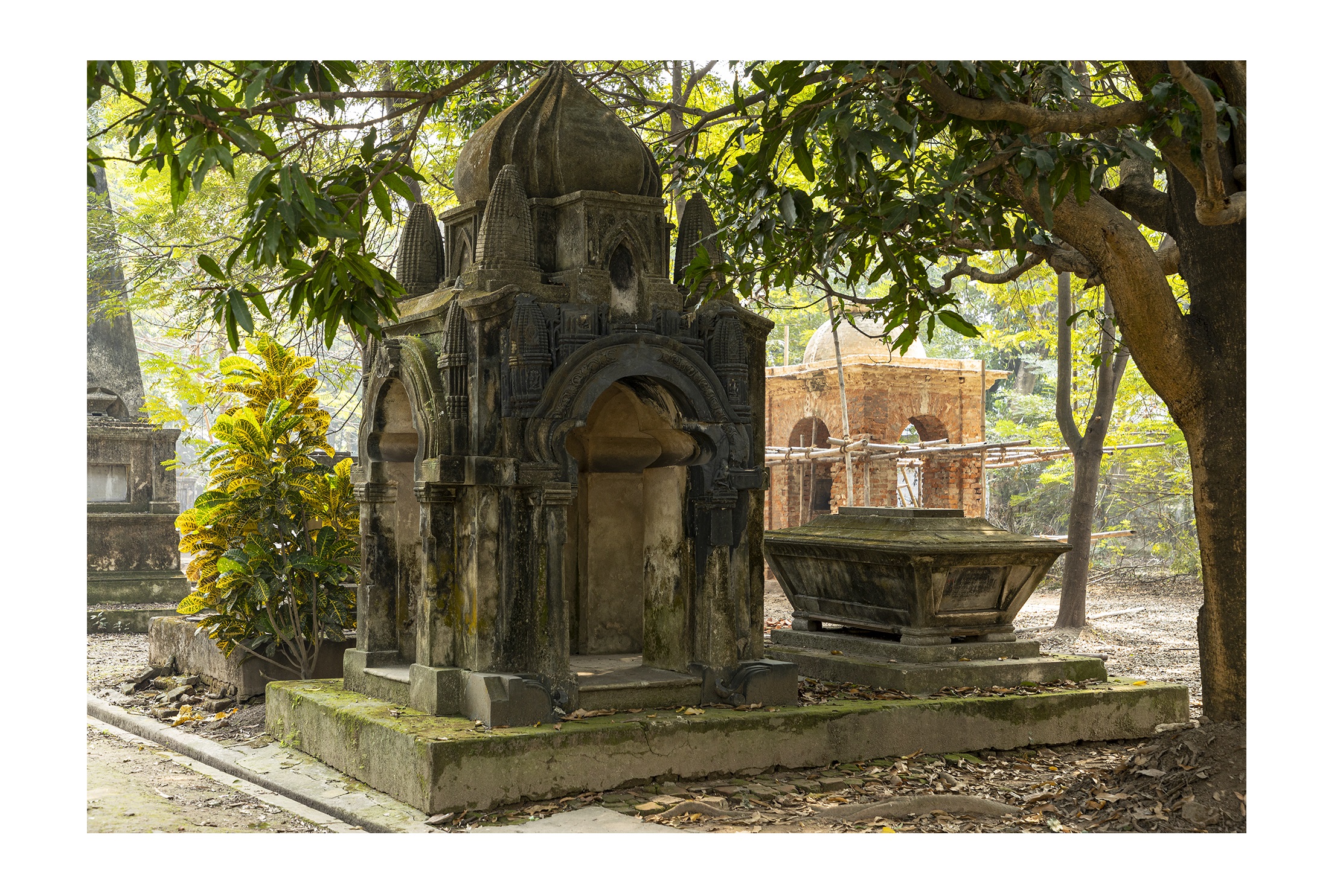
Later, the inscriptions were returned to Bhubaneswar in 1837 at the suggestion of Major Markham Kittoe. Two of the returned inscriptions, one of Bhatta Bhavadeva and the other of Megheswar, were fixed to the compound wall of Ananta-Vasudeva Temple. The third, Brahmeswar inscription, unfortunately never reached Bhubaneswar, probably lost forever in transit.
The Deities
Constructed in the 13th Century, the deities are more or less similar to the famous Jagannath Temple in Puri only in variation of Krishna here in place of Lord Jagannath. Balarama & Subhadra remain the same here but in different posture and materials also. Here the stone images are jointly known as “Silabrahma” compared to “Darubrahma” of the Puri temple. While Balarama (Lord Ananta, incarnation of Seshnag) is under a seven hooded serpent “Ananta Naga” over his head, sister Subhadra is holding a lotus in one hand and the jewel in another hand. Her left foot is on another jewelry pot. Krishna is holding Sankha (Conch), Chakra, Gada (Mace), and Padma (Lotus) in a unique style. Normally, Chakra is seen in the right hand of Lord Krishna, but here Chakra is on the bottom left hand of Lord Vishnu. It is said that due to the presence of Chakra in Krishna’s hand, the city is known as Chakra Kshetra and Puri as Sankha Kshetra. All the deities are made of black granite stone compared to wood in the Jagannath Temple.
Note: Deity Photo has not been taken as per request of servitors present therein.
The ‘Parsva-Devatas’ are three of the ten incarnations of Vishnu, of which the four-armed “Varahaand Trivikrama”, both mutilated, now exist in the south and north niches respectively. As in the Lingaraja temple, there were porches in front of the ‘Parsva-Devatas’, only the eastern one now standing. These porches were integral parts of the original scheme of the porch. In the decoration of the ‘Bada’, the ‘Jagamohana’ closely follows the ‘Deul’. The ‘Dikpalas’ and their female counterparts are also depicted here in the ‘Khakhara’ and ‘Pidha-Mundis’ of the lower and upper ‘Janghas’ between the corner and intermediary ‘Rathas’. The carvings on the central projections containing a banister window are neatly done. The banisters of the north window have the figures of Rama, Lakshmana, Sita, Hanuman, and a monkey attendant.

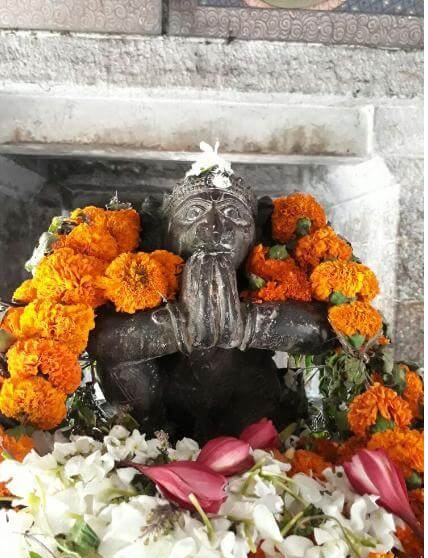
Temple Architecture
Truly speaking, Ananta Vasudeva Temple resembles a lot like the Lingaraj Temple, situated only 300 meters away from it. But, in addition, it is boasted of Lord Vishnu-related Vaishnavite sculptures. The exterior wall sculpture is also different and depicts various aspects of lifestyle, worship, and regular practices.
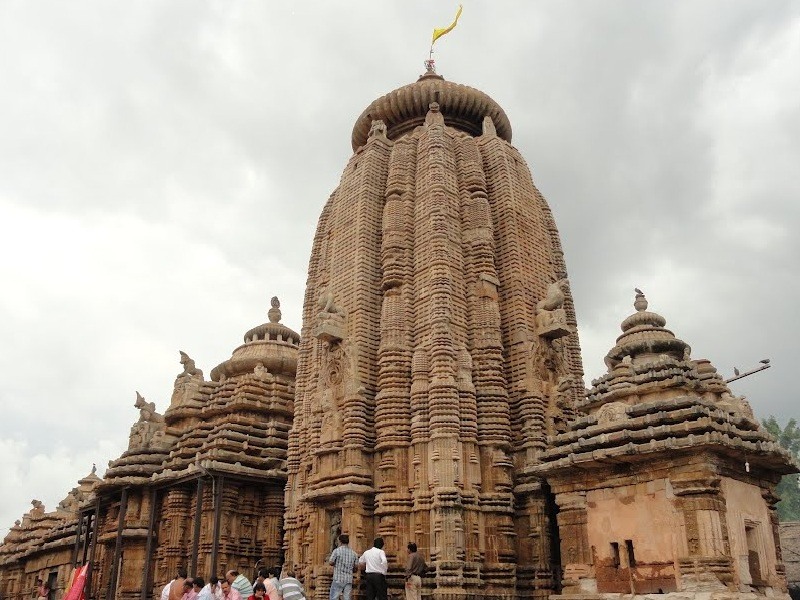
The temple has longitudinal shikhara with beautiful carvings. It contains a three-chambered frontal adjunct consisting of Jagamohan, Natamandapa, and Bhogamandapa with all units aligned on a single east-west axis. The Natamandapa and Bhogamandapa were added later. It has longitudinal bands of miniature shrines carved with ornaments also. If you notice, you can find that it is positioned in a walled compound along with abundant structures. An image on the wall of the temple displays legend of Lord Vishnu who appears as Varaha’s avatar here in this temple.

Wall Art
You need to have a special eye to go through the decorations, idols, structures, postures present almost in every wall of this temple. Here are a few samples:

This temple looks almost like a reduced copy of the Lingaraja temple. But the grouping of the four parts, with their roofs presenting the appearance of ascending peaks culminating in the highest ‘Mastaka’ of the ‘Deul’ at a height of 18.29 meters, is different from all others. It is further distinguished by an ornamental platform, relieved with ‘Khakhara-Mundis’, carved pilasters, ‘Nagas’, ‘Nagis’ and ‘Vidalas’ between two sets of three moldings each.

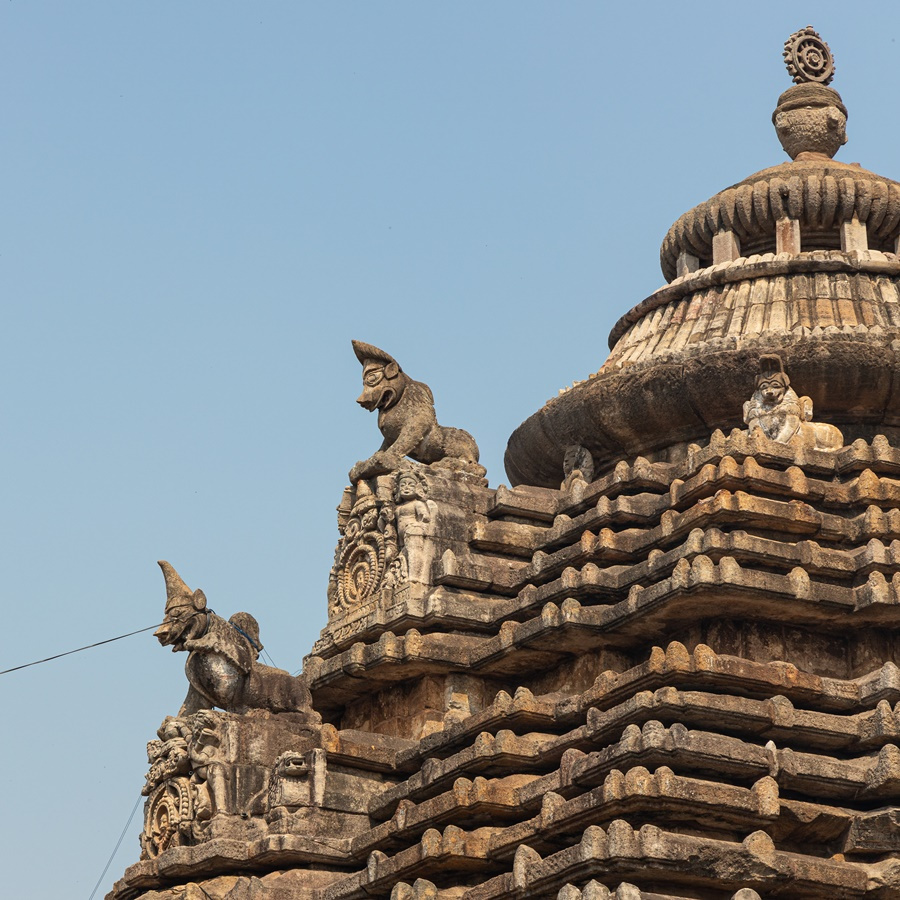
Jagamohan is a built-in Pancha-Ratha style consisting of Pabhaga , Jangha, and Baranda. Pabhaga has five moldings, Jangha is divided into two floors separate by a Madhya-Bandhana of three mouldings, and Baranda has seven mouldings. Dikpalas are shown on the anuraha recess on lower storey while their corresponding shaktis are on the upper storey of the same recess.

Raha-Paga is in form of Gavaksha (window) projecting out from the wall. This Gavaksha has five balusters carved with various figures. On the north gavaksha is seen Rama, Lakshmana and Sita accompanied by a monkey on each side, the monkey can be identified with Hanumana and Vibhishana. On south gavaksha only two balustrade are situated where gopis are carved. The missing three were carved with Krishna and gopis and detached to be fitted into another miniature shrine at the bank of Bindusarovar.

Even, there is another ruined structure also present inside the temple, although no such history is found nowadays about it.

Temple Kitchen
Probably after Lord Jagannath Temple at Puri, the kitchen of Ananta Vasudeva Temple holds the center stage to all the devotees. Vegetarian food is prepared daily for thousands of people and is cooked in virgin earthen pots same as ‘abhada bhoga’ in Puri. There are huge earthen stoves ignited with firewood and no onion or garlic is used in the “Bhoga”. There is a “Bhoga Bazaar” adjoined to the temple to serve food to the devotees, same in line with the “Ananda Bazaar” in Puri.

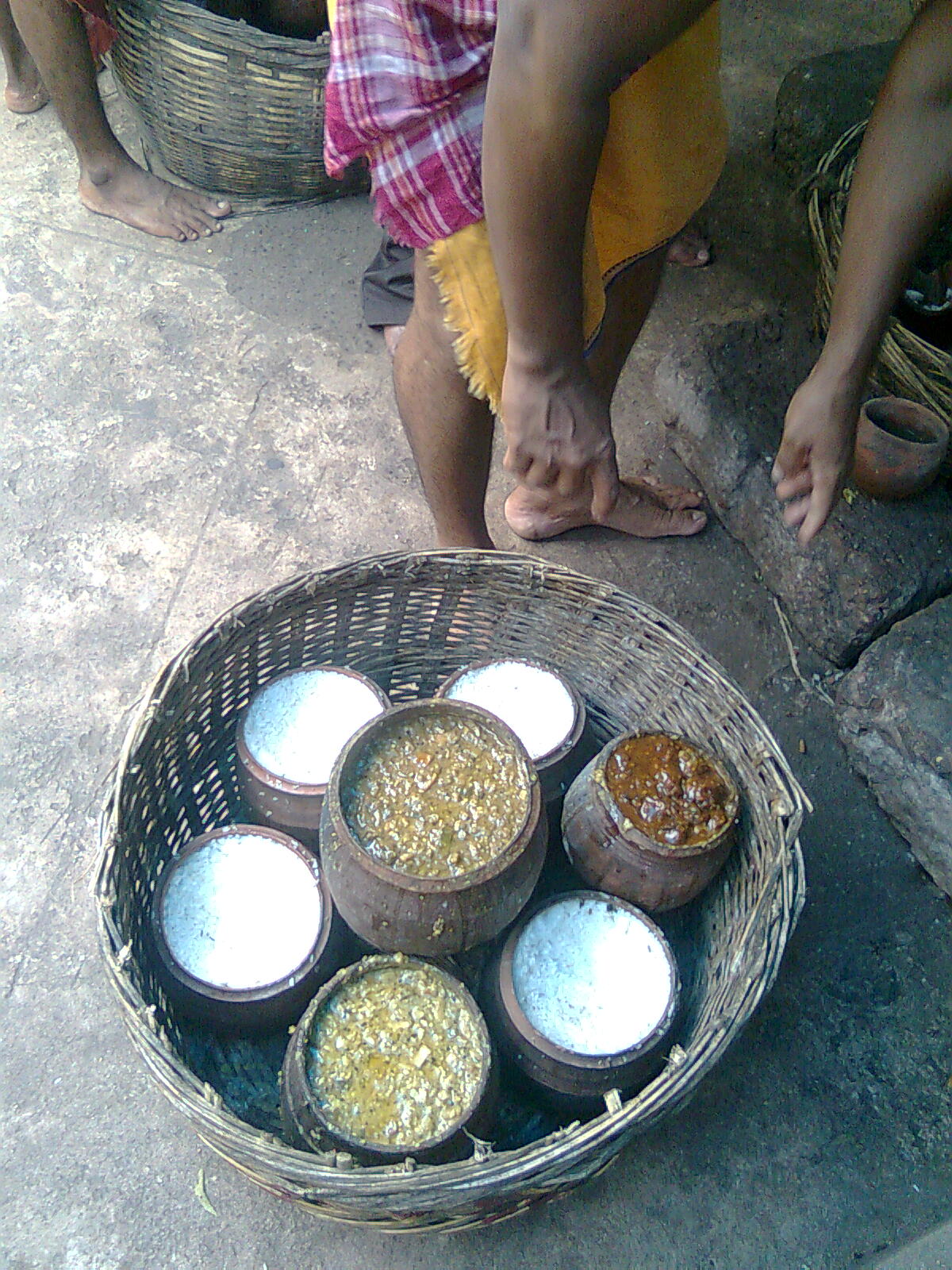
Celebration Time
Although daily “Aarati” is observed at the temple but devotes throng in the time of “Janmashtami” when the temple hosts a huge celebration with devotional song and prayer.
Other Facts
This is a west-facing temple unlike any other in the region. Bhubaneswar has lots of Shiva temples but hardly any other “Vishnu” temple like this. It is believed that this is the holy place where Shiva waited for Lord Vishnu to stay in this part of the world. Pilgrims do maintain such still and they visit Ananta Vasudeva Temple at first, then rest temples to express their gratitude to both Lord Vishnu & God Shiva.
How to Reach Ananta Vasudeva Temple?
- By Air – Bhubaneswar Airport is the nearest option. From Airport, it is only 3.5 KM away and you can book Cab or Auto to reach the temple in 10-15 minutes.
- By Train – If you are planning to reach Bhubaneswar by Train, then you can find numerous trains from all over India. it is very close to Station (Master Canteen) and it will hardly take 10 minutes from Station to the temple.
- By Road – If you are dropped at Baramunda Bus Stop/Master Canteen, then you can take either cab or auto to reach the temple very easily. The National Highway is also equally good if you prefer to drive your car from any part of India.
Where to Stay at Bhubaneswar?
If you want to stay just beside Ananta Vasudeva Temple with the intention to visit the famous Lingaraj Temple also, then there are a few adjacent hotels & Dharamshala. If you want to explore more temples in and around Bhubaneswar along with other tourist spots, then it is advisable to spend nights at Bhubaneswar city. You will find a good number of star categories as well as economy hotels for accommodation and food.
Best Time to Visit Ananta Vasudeva Temple?
Well, the temple is open throughout the year. So you are welcome anytime. But if you want to see the crowd thronging into the temple and offering Puja, then Janmashtami is the ideal time. You can come in the morning or in the evening to see the Puja along with Arati.
![]()
Image(s) Source: Self
অনেক ভালো লাগলো।
সমৃদ্ধ হলাম।
Thank U
Wow sir…..great information
The article is full of information. It helps the students of history as well as the travellers.